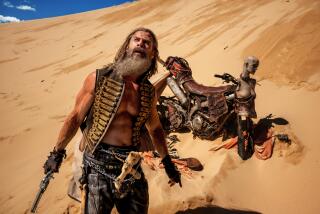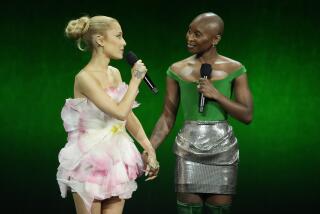Focusing on the Big Picture With Films in CinemaScope
- Share via
It was one of Hollywood’s responses to the advent of television: a system of presenting motion pictures using images at least twice as wide as they were tall. Employed on movies ranging from “West Side Story” to “Barabbas,” it expanded the “squarish” canvas previously in vogue, enticing people back into theaters with epic size and scale. Perfected by a Frenchman, Henri Chretien, in the late 1920s, the system was licensed by 20th Century Fox production chief Darryl F. Zanuck in the early 1950s. When “The Robe” opened on Sept. 16, 1953, “CinemaScope” made its American theatrical debut.
The technique, which thrived in the 1950s and 1960s, faded somewhat in the following decade with the demise of musicals, westerns and spectaculars, as well as wide-screen theaters themselves. But propelled by a new generation of film-wise directors like Quentin Tarantino (“Pulp Fiction”) and Neil Jordan (“Crying Game”), wide-screen movie-making is enjoying a resurgence, surfacing in such movies as “Richard III,” “Braveheart” and “The Usual Suspects.”
Films shot in this format will be the focus of a series that begins Friday at the Los Angeles County Museum of Art’s Bing Theatre called “The Big Picture: Films on the Wide Screen,” curated by Todd McCarthy, chief film critic for Variety.
“We’re aiming at two audiences,” McCarthy said. “People who were around in the ‘50s and ‘60s, who booked a reserved seat ticket to ‘Mutiny on the Bounty’ or ‘Lawrence of Arabia’ like they would a ticket to ‘Phantom of the Opera,’ as well as younger people who have only heard about these movies or, at best, seen them on video. ‘Wide-screen’ was that era’s version of an ‘event film.’ ”
Still, the process was not universally embraced, particularly in the early days before the lenses were dramatically perfected. Fritz Lang (“Metropolis”) remarked that the process was good only for “shooting snakes and funerals.” The legendary John Ford compared the wide screen to a big tennis court. Others complained about the awkwardness of close-ups, the stationary camera and the lack of depth.
“ ‘Ben-Hur’ with Roman legions crossing the hills, sea battles and chariot races lent itself to that kind of composition,” said Richard P. May, vice president of film preservation and distribution services at Turner Entertainment Co. “A drawing room drama--or ‘Babe’--does not.”
*
The wide-screen technique was initially applied indiscriminately, with varied degrees of success, McCarthy acknowledged. An early CinemaScope film like “How to Marry a Millionaire” (screening Saturday) had more of a stagy quality conveying the impression actors were walking back and forth on a proscenium. “Bad Day at Black Rock” (March 9) and “The Great Escape” (March 16), in contrast, were more effective in filling the space.
Finding prints presentable for theatrical release was a challenge, involving months of legwork on the curator’s part.
“You can see ‘Solomon and Sheba’ or Liz Taylor in ‘Cleopatra’ on laser or video, but there is no quality 35-millimeter print,” McCarthy said. “The same goes for Brando in ‘Mutiny on the Bounty’ and even Disney’s ‘Sleeping Beauty.’ It costs several thousand dollars to make a new print and, with a reduction in the number of ‘revival houses,’ studio perception is that there’s no audience there. The LACMA series is not only a touch of nostalgia but possibly the last chance to see some of these movies on the big screen.”
As long as the pictures survive, in any form, it’s less of a tragedy, said Michael Schlesinger, director of acquisitions and repertory sales for Sony Pictures Releasing. But seeing them on laser or video is “a compromise.”
“Movies are made on film, and they should be preserved on film,” he said. “Movies were also meant to be seen in theaters so people should continue to have that option. And even if it’s just two people talking--as they were in ‘The Whole Wide World,’ screened at Sundance--the wide-screen process gives movies a magical quality, inner grandeur.
“If you have two eyes, your range of vision is ‘wide screen’--close one and it’s television,” he explained. “As John Carpenter, a big advocate of the technique, commented to cinematographer William Fraker on the set of his ‘Memoirs of an Invisible Man’: ‘It’s ‘Scope that makes it a movie.’ ”
* Tickets and other information may be obtained by calling (213) 857-6010.
More to Read
Only good movies
Get the Indie Focus newsletter, Mark Olsen's weekly guide to the world of cinema.
You may occasionally receive promotional content from the Los Angeles Times.










